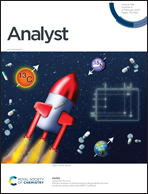Rational design of a turn-on near-infrared fluorescence probe for the highly sensitive and selective monitoring of carboxylesterase 2 in living systems†
Abstract
In vivo selective fluorescence imaging of carboxylesterase 2 (CES2) remains a great challenge because existing fluorescence probes can potentially suffer from interference by other hydrolases. In addition, some fluorescent probes that have been separately reported for measuring CES2 activity in vitro are affected by autofluorescence and absorption of the biological matrix due to their limited emission wavelength or short Stokes shift. Herein, based on the substrate preference and catalytic performance of CES2, a novel and NIR fluorescent probe was developed, in which a hemi-cyanine dye ester derivative was used as the basic fluorescent group. In the presence of CES2, the probe was hydrolyzed to expose the fluorophore CZX-OH (λabs ∼ 675 nm, λem ∼ 850 nm), which led to a notable red-shift in the fluorescence (∼175 nm) spectrum. Confocal imaging of cells and live mice demonstrated that the fluorescent signal of this probe was related to the real activities of CES2 in cancer cells. All these results will powerfully promote the screening of CES2 regulators and the analysis of CES2-related physiological and pathological processes.



 Please wait while we load your content...
Please wait while we load your content...